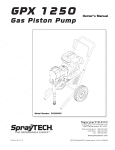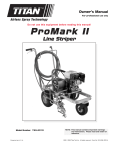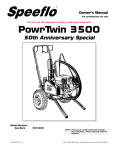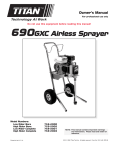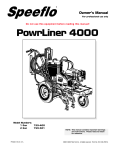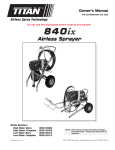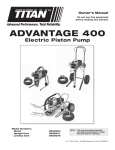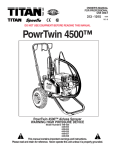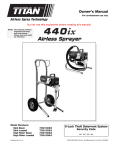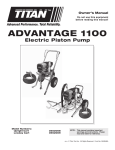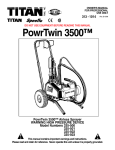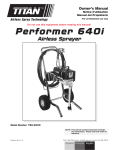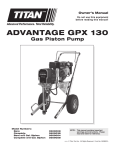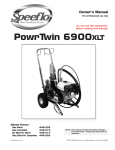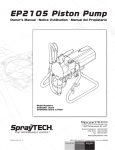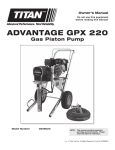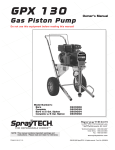Download EPX2305 01
Transcript
EPX2305
Piston Pump
Owner’s Manual
Model Numbers:
0507007 Upright Cart
0507017 Low Boy Cart
SprayTECH
1770 Fernbrook Lane
Minneapolis, MN 55447
Technical Assistance: 1-800-292-4637
Order Entry: 1-800-443-4500
Fax: 1-800-525-9501
w w w. s p ray t e chinc .c om
Printed in the U. S. A.
0302 © 2002 SprayTECH. All rights reserved. Form No. 0507824A
Table of Contents
• NEVER allow any part of the body to touch the fluid stream.
DO NOT allow body to touch a leak in the fluid hose.
• NEVER put hand in front of the gun. Gloves will not
provide protection against an injection injury.
• ALWAYS lock gun trigger, shut pump off, and release all
pressure before servicing, cleaning tip or guard, changing
tip, or leaving unattended. Pressure will not be released
by turning off the motor. The PRIME/SPRAY valve handle
must be turned to PRIME to relieve the pressure. Refer to
the PRESSURE RELIEF PRESSURE described in the
pump manual.
• ALWAYS keep tip guard in place while spraying. The tip
guard provides some protection but is mainly a warning
device.
• ALWAYS remove the spray tip before flushing or cleaning
the system.
• Paint hose can develop leaks from wear, kinking and
abuse. A leak can inject material into the skin. Inspect
the hose before each use.
• NEVER use a spray gun without a working trigger lock
and trigger guard in place.
• All accessories must be rated at or above 3200 PSI/221
BAR. This includes spray tips, guns, extensions, and
hose.
Safety Precautions .................................................................2
Français ..............................................................................14
Español ...............................................................................16
General Description ...............................................................4
Operation ................................................................................4
Setup ....................................................................................4
Preparing to Paint .................................................................4
Painting .................................................................................5
Pressure Relief Procedure ...................................................5
Spraying ..................................................................................6
Spraying Technique ..............................................................6
Practice .................................................................................6
Cleanup ...................................................................................6
Maintenance............................................................................7
General Repair and Service Notes.......................................7
Replacing the PRIME/SPRAY Valve.....................................7
Replacing the Filters .............................................................8
Replacing the Motor Assembly .............................................8
Replacing the Gears .............................................................9
Replacing the Transducer.....................................................9
Servicing the Fluid Section .................................................10
Troubleshooting ...................................................................12
Parts List ...............................................................................18
Main Assembly....................................................................18
Drive Assembly ...................................................................19
Suction Set Assembly (Low Boy) .......................................19
Labels .................................................................................19
Fluid Section Assembly ......................................................20
Upright Cart Assembly ........................................................21
Filter Assembly ...................................................................21
Pressure Control Assembly ................................................22
Low Boy Cart Assembly......................................................22
PRIME/SPRAY Assembly ...................................................23
Electrical Schematic ...........................................................23
Accessories ........................................................................23
Limited Warranty ..................................................................24
NOTE TO PHYSICIAN:
Injection into the skin is a traumatic injury. It is
important to treat the injury as soon as possible. DO
NOT delay treatment to research toxicity. Toxicity is a
concern with some coatings injected directly into the
blood stream. Consultation with a plastic surgeon or
reconstructive hand surgeon may be advisable.
HAZARD: EXPLOSION AND FIRE - Solvent and paint
fumes can explode or ignite. Severe injury
and/or property damage can occur.
PREVENTION:
• Provide extensive exhaust and fresh air introduction to
keep the air within the spray area free from accumulation
of flammable vapors.
• Avoid all ignition sources such as static electricity sparks,
electrical appliances, flames, pilot lights, hot objects, and
sparks from connecting and disconnecting power cords or
working light switches.
• Do not smoke in spray area.
• Fire extinguisher must be present and in good working
order.
• Place pump at least 20 feet (6.1 m) from the spray object
in a well ventilated area (add more hose if necessary).
Flammable vapors are often heavier than air. Floor area
must be extremely well ventilated. The pump contains
arcing parts that emit sparks and can ignite vapors.
• The equipment and objects in and around the spray area
must be properly grounded to prevent static sparks.
• Use only conductive or grounded high-pressure fluid hose.
Gun must be grounded through hose connections.
• Power cord must be connected to a grounded circuit.
• Always flush unit into separate metal container, at low
pump pressure, with spray tip removed. Hold gun firmly
against side of container to ground container and prevent
static sparks.
• Follow material and solvent manufacturer's warnings and
instructions.
• Use extreme caution when using materials with a
flashpoint below 70° F (21° C). Flashpoint is the
temperature at which a fluid can produce enough vapors
to ignite.
• Plastic can cause static sparks. Never hang plastic to
enclose spray area. Do not use plastic drop cloths when
spraying flammable materials.
• Use lowest possible pressure to flush equipment.
Safety Precautions
This manual contains information that must be read and
understood before using the equipment. When you come to an
area that has one of the following symbols, pay particular
attention and make certain to heed the safeguard.
WARNING
This symbol indicates a potential hazard that may cause
serious injury or loss of life. Important safety information will
follow.
CAUTION
This symbol indicates a potential hazard to you or to the
equipment. Important information that tells how to prevent
damage to the equipment or how to avoid causes of minor
injuries will follow.
NOTE: Notes give important information which should
be given special attention.
WARNING
HAZARD: Injection injury - A high pressure fluid stream
produced by this equipment can pierce the
skin and underlying tissues, leading to serious
injury and possible amputation. See a
physician immediately.
DO NOT TREAT AN INJECTION INJURY AS A SIMPLE
CUT! Injection can lead to amputation. See a physician
immediately.
The maximum operating range of the sprayer is 3200
PSI/221BAR fluid pressure.
PREVENTION:
• NEVER aim the gun at any part of the body.
2
© SprayTECH. All rights reserved.
Grounding Instructions
GAS ENGINE (WHERE APPLICABLE)
Always place sprayer outside of structure in fresh air. Keep all
solvents away from engine exhaust. Never fill fuel tank with a
running or hot engine. Hot surface can ignite spilled fuel.
Always attach ground wire from pump to a grounded object.
Refer to engine owner’s manual for complete safety
information.
HAZARD: EXPLOSION HAZARD DUE TO INCOMPATIBLE
MATERIALS - will cause severe injury or
property damage.
PREVENTION:
• Do not use materials containing bleach or chlorine.
• Do not use halogenated hydrocarbon solvents such as
bleach, mildewcide, methylene chloride and 1,1,1 trichloroethane. They are not compatible with aluminum.
• Contact your coating supplier about the compatibility of
material with aluminum.
HAZARD: HAZARDOUS VAPORS - Paints, solvents,
insecticides, and other materials can be
harmful if inhaled or come in contact with body.
Vapors can cause severe nausea, fainting, or
poisoning.
PREVENTION:
• Use a respirator or mask if vapors can be inhaled. Read
all instructions supplied with the mask to be sure it will
provide the necessary protection.
• Wear protective eyewear.
• Wear protective clothing as required by coating
manufacturer.
HAZARD: GENERAL - Can cause severe injury or
property damage.
PREVENTION:
• Read all instructions and safety precautions before
operating equipment.
• Follow all appropriate local, state, and national codes
governing ventilation, fire prevention, and operation.
• The United States Government Safety Standards have
been adopted under the Occupational Safety and Health
Act (OSHA). These standards, particularly part 1910 of
the General Standards and part 1926 of the Construction
Standards, should be consulted.
• Use only manufacturer authorized parts. User assumes
all risks and liabilities when using parts that do not meet
the minimum specifications and safety devices of the
pump manufacturer.
• Before each use, check all hoses for cuts, leaks, abrasion
or bulging of cover. Check for damage or movement of
couplings. Immediately replace hose if any of those
conditions exist. Never repair a paint hose. Replace with
a grounded high-pressure hose.
• All hoses, swivels, guns, and accessories must be
pressure rated at or above 3200PSI/221 BAR.
• Do not spray outdoors on windy days.
• Wear clothing to keep paint off skin and hair.
• Always unplug cord from outlet before working on
equipment.
© SprayTECH. All rights reserved.
This product must be grounded. In the event of an electrical
short circuit, grounding reduces the risk of electric shock by
providing an escape wire for the electric current. This product
is equipped with a cord having a grounding wire with an
appropriate grounding plug. The plug must be plugged into an
outlet that is properly installed and grounded in accordance
with all local codes and ordinances.
DANGER — Improper installation of the grounding plug can
result in a risk of electric shock. If repair or replacement of the
cord or plug is necessary, do not connect the green grounding
wire to either flat blade terminal. The wire with insulation
having a green outer surface with or without yellow stripes is
the grounding wire and must be connected to the grounding
pin.
Check with a qualified electrician or serviceman if the
grounding instructions are not completely understood, or if you
are in doubt as to whether the product is properly grounded.
Do not modify the plug provided. If the plug will not fit the
outlet, have the proper outlet installed by a qualified
electrician.
Grounded Outlet
Grounding Pin
Cover for grounded outlet box
CAUTION
Use only a 3-wire extension cord that has a 3-blade
grounding plug and a 3-slot receptacle that will accept the
plug on the product. Make sure your extension cord is in
good condition. When using an extension cord, be sure
to use one heavy enough to carry the current your
product will draw. An undersized cord will cause a drop
in line voltage resulting in loss of power and overheating.
A 12 gauge cord is recommended. If an extension cord is
to be used outdoors, it must be marked with the suffix WA after the cord type designation. For example, a
designation of SJTW-A would indicate that the cord would
be appropriate for outdoor use.
3
General Description
CAUTION
This airless sprayer is a precision power tool used for spraying
many types of materials. Read and follow this instruction
manual carefully for proper operating instructions,
maintenance, and safety information.
Always use a minimum 12 gauge, three-wire extension
cord with a grounded plug. Never remove the third prong
or use an adapter.
Preparing a New Sprayer
ON/OFF
Switch
If this unit is new, it is shipped with test fluid in the fluid section
to prevent corrosion during shipment and storage. This fluid
must be thoroughly cleaned out of the system with mineral
spirits before you begin spraying.
Pressure
Control
Knob
Motor
CAUTION
Filter
Oil Cup
Always keep the trigger lock on the spray gun in the
locked position while preparing the system.
1. Place the siphon tube into a container of mineral spirits.
2. Place the return hose into a metal waste container.
3. Set the pressure to minimum by turning the pressure
control knob fully counterclockwise.
Circuit
Breaker
PRIME/
SPRAY
Valve
Fluid
Section
Pressure Control Knob
Return
Hose
Siphon
Tube
Operation
ON/OFF Switch
4. Move the PRIME/SPRAY valve down to the PRIME
position.
5. Turn the unit on by moving the ON/OFF
switch to the ON position.
6. Allow the sprayer to run for 15–30
seconds to flush the test fluid out
through the return hose and into the
waste container.
7. Turn the unit off by moving the ON/OFF
switch to the OFF position.
PRIME/SPRAY
Valve
WARNING
This equipment produces a fluid stream at extremely high
pressure. Read and understand the warnings in the
Safety Precautions section at the front of this manual
before operating this equipment.
Setup
Perform the following procedure before plugging in the power
cord of an electric unit.
1. Ensure that the siphon tube/suction set and the return
hose are attached and secure.
2. Using a wrench, attach a minimum of 50’ of 1/4” nylon
airless spray hose to the unit. Tighten securely.
3. Attach an airless spray gun to the spray hose. Using two
wrenches (one on the gun and one on the hose), tighten
securely.
Preparing to Paint
Before painting, it is important to make sure that the fluid in the
system is compatible with the paint that is going to be used.
NOTE: Incompatible fluids and paint may cause the
valves to become stuck closed, which would
require disassembly and cleaning of the
sprayer’s fluid section.
NOTE: Do not attach the tip to the spray gun yet.
Remove the tip if it is already attached.
CAUTION
WARNING
Always keep the trigger lock on the spray gun in the
locked position while preparing the system.
1. Place the siphon tube into a container of the appropriate
solvent. Examples of the appropriate solvent are water for
latex paint or mineral spirits for oil-based paints.
2. Place the return hose into a metal waste container.
3. Set the pressure to minimum by turning the pressure
control knob fully counterclockwise.
4. Move the PRIME/SPRAY valve down to the PRIME
position.
5. Turn the unit on by moving the ON/OFF switch to the ON
position.
6. Allow the sprayer to run for 15–30 seconds to flush the old
solvent out through the return hose and into the metal
waste container.
7. Turn the unit off by moving the ON/OFF switch to the OFF
position.
NOTE: Make sure that the spray gun does not have a
tip or tip guard installed.
Make sure all airless hoses and spray guns are electrically
grounded and rated for at least 3200 psi (221 bar) fluid
pressure.
4. Make sure the pressure control knob is turned fully
counterclockwise to its lowest pressure setting.
5. Fill the oil cup with approximately one tablespoon of
separating oil (P/N 0279920).
CAUTION
Never operate unit for more than ten seconds without
fluid. Operating this unit without fluid will cause
unnecessary wear to the packings.
6. Make sure the electrical service is 120V, 15 amp
minimum.
7. Plug the power cord into a properly grounded outlet at
least 25’ from the spray area.
4
© SprayTECH. All rights reserved.
8. Move the PRIME/SPRAY valve up to the SPRAY position.
9. Turn the unit on.
10. Unlock the gun by turning the gun trigger lock to the
unlocked position.
WARNING
Ground the gun by holding it against
the edge of the metal container while
flushing. Failure to do so may lead to a
static electric discharge, which may
cause a fire.
12. Trigger the gun into the metal waste
container until all air and solvent is
flushed from the spray hose and paint is flowing freely
from the gun.
13. Lock the gun by turning the gun trigger lock to the locked
position.
14. Turn the unit off.
15. Attach tip guard and tip to the gun as instructed by the tip
guard or tip manuals.
WARNING
Ground the gun by holding it against
the edge of the metal container while
flushing. Failure to do so may lead to a
static electric discharge, which may
cause a fire.
11. Trigger the gun into the metal waste
container until the old solvent is gone
and fresh solvent is coming out of the gun.
12. Lock the gun by turning the gun trigger lock to the locked
position.
13. Set down the gun and increase the pressure by turning
the pressure control knob slowly clockwise.
14. Check the entire system for leaks. If leaks occur, turn the
unit off and follow the “Pressure Relief Procedure” in this
manual before tightening any fittings or hoses.
15. Follow the “Pressure Relief Procedure” in this manual
before changing from solvent to paint.
WARNING
POSSIBLE INJECTION HAZARD. Do not spray without the
tip guard in place. Never trigger the gun unless the tip is
in either the spray or the unclog position. Always engage
the gun trigger lock before removing, replacing or
cleaning tip.
16. Turn the unit on.
17. Increase the pressure by turning the pressure control
knob slowly clockwise and test the spray pattern on a
piece of cardboard. Adjust the pressure control knob until
the spray from the gun is completely atomized. Try to
keep the pressure control knob at the lowest setting that
maintains good atomization.
WARNING
Be sure to follow the pressure relief procedure when
shutting the unit down for any purpose, including
servicing or adjusting any part of the spray system,
changing or cleaning spray tips, or preparing for cleanup.
Painting
NOTE: Turning the pressure up higher then needed to
atomize the paint will cause premature tip wear
and additional overspray.
1. Place the siphon tube into a container of paint.
2. Place the return hose into a metal waste container.
3. Set the pressure to minimum by turning the pressure
control knob fully counterclockwise.
Pressure Relief Procedure
Pressure Control Knob
WARNING
Be sure to follow the pressure relief procedure when
shutting the unit down for any purpose, including
servicing or adjusting any part of the spray system,
changing or cleaning spray tips, or preparing for cleanup.
1. Lock the gun by turning the gun trigger lock to the locked
position.
2. Turn the unit off by moving the ON/OFF switch to the OFF
position.
3. Set the pressure to minimum by turning the pressure
control knob fully counterclockwise.
4. Unlock the gun by turning the gun trigger lock to the
unlocked position.
5. Hold the metal part of the gun firmly to
the side of a metal container to ground
the gun and avoid a build up of static
electricity.
6. Trigger the gun to remove any
pressure that may still be in the hose.
7. Lock the gun by turning the gun trigger
lock to the locked position.
8. Move the PRIME/SPRAY valve down to the PRIME
position.
ON/OFF Switch
4. Move the PRIME/SPRAY valve down to the PRIME
position.
5. Turn the unit on by moving the ON/OFF
switch to the ON position.
6. Allow the sprayer to run until paint is
coming through the return hose into the
metal waste container.
7. Turn the unit off by moving the ON/OFF
switch to the OFF position.
8. Remove the return hose from the waste
PRIME/SPRAY
container and place it in its operating
Valve
position above the container of paint.
9. Move the PRIME/SPRAY valve up to the SPRAY position.
10. Turn the unit on.
11. Unlock the gun by turning the gun trigger lock to the
unlocked position.
© SprayTECH. All rights reserved.
5
Spraying
The spray gun should be triggered by turning it on and off with
each stroke. This will save paint and avoid paint buildup at the
end of the stroke. Do not trigger the gun during the middle of
a stroke. This will result in an uneven spray and splotchy
coverage.
NOTE: When spraying block filler, mastics or high
solid coating, remove the gun filter and high
pressure filter screens.
Proper way to trigger the spray gun
Spraying Technique
The key to a good paint job is an even coating over the entire
surface. This is done by using even strokes. Keep your arm
moving at a constant speed and keep the spray gun at a
constant distance from the surface. The best spraying
distance is 10 to 12 inches between the spray tip and the
surface.
Keep stroke
even
Approximately
10 to 12 inches
Even coat throughout
Start stroke
Approximately
10 to 12 inches
Pull trigger
Keep steady
Release trigger
End stroke
Overlap each stroke by about 30%. This will ensure an even
coating.
When you stop painting, lock the gun trigger lock, turn the
pressure control knob counterclockwise to its lowest setting
and set the PRIME/SPRAY valve to PRIME. Turn the ON/OFF
switch to the OFF position and unplug the sprayer.
Practice
1. Be sure that the paint hose is free of kinks and clear of
objects with sharp cutting edges.
2. Turn the pressure control knob counterclockwise to its to
its lowest setting.
3. Move the PRIME/SPRAY valve up to the
SPRAY position.
4. Turn the pressure control knob
clockwise to its highest setting. The
paint hose should stiffen as paint begins
to flow through it.
5. Unlock the gun trigger lock.
6. Trigger the spray gun to bleed air out of
PRIME/SPRAY
the hose.
Valve
7. When paint reaches the spray tip, spray a test area to
check the spray pattern.
8. Use the lowest pressure
setting necessary to get a
good spray pattern. If the
pressure is set too high, the
Good spray pattern
spray pattern will be too light.
If the pressure is set too low,
tailing will appear or the paint
will spatter out in gobs rather
than in a fine spray.
Paint tailing pattern
Keep stroke smooth and at an even speed.
Keep the spray gun at right angles to the surface. This means
moving your entire arm back and forth rather than just flexing
your wrist.
Light Coat
Heavy Coat
Light Coat
Do not flex wrist while spraying.
Keep the spray gun perpendicular to the surface, otherwise
one end of the pattern will be thicker than the other.
Cleanup
Approximately
10 to 12 inches
WARNING
Right way
Special cleanup instructions for use with flammable
solvents:
• Always flush spray gun preferably outside and at least one
hose length from spray pump.
• If collecting flushed solvents in a one gallon metal
container, place it into an empty five gallon container, then
flush solvents.
• Area must be free of flammable vapors.
• Follow all cleanup instructions.
Wrong way
CAUTION
The sprayer, hose, and gun should be cleaned thoroughly
after daily use. Failure to do so permits material to build
up, seriously affecting the performance of the unit.
6
© SprayTECH. All rights reserved.
Maintenance
WARNING
WARNING
Always spray at minimum pressure with the gun nozzle tip
removed when using mineral spirits or any other solvent
to clean the sprayer, hose, or gun. Static electricity
buildup may result in a fire or explosion in the presence of
flammable vapors.
1. Follow the “Pressure Relief Procedure” found in the
Operation section of this manual.
2. Remove the gun tip and tip guard and clean with a brush
using the appropriate solvent.
3. Place the siphon tube into a container of the appropriate
solvent. Examples of the appropriate solvent are water for
latex paint or mineral spirits for oil-based paints.
4. Place the return hose into a metal waste container.
5. Set the pressure to minimum by
Pressure
Control Knob
turning the pressure control knob
fully counterclockwise.
6. Move the PRIME/SPRAY valve down
to its PRIME position.
7. Turn the unit on by moving the
ON/OFF switch to the ON position.
8. Allow the solvent to circulate
through the unit and flush the paint ON/OFF
out of the return hose into the metal Switch
waste container.
9. Turn the unit off by moving the ON/OFF switch to the OFF
position.
10. Move the PRIME/SPRAY valve up to its SPRAY position.
11. Turn the unit on.
Before proceeding, follow the Pressure Relief Procedure
outlined previously in this manual. Additionally, follow all
other warnings to reduce the risk of an injection injury,
injury from moving parts or electric shock. Always unplug
the sprayer before servicing!
General Repair and Service Notes
1. Before repairing any part of the sprayer, read the
instructions carefully, including all warnings.
CAUTION
Never pull on a wire to disconnect it. Pulling on a wire
could loosen the connector from the wire.
2. Test your repair before regular operation of the sprayer to
be sure that the problem is corrected. If the sprayer does
not operate properly, review the repair procedure to
determine if everything was done correctly. Refer to the
Troubleshooting section to help identify other possible
problems.
3. Make certain that the service area is well ventilated in
case solvents are used during cleaning. Always wear
protective eyewear while servicing. Additional protective
equipment may be required depending on the type of
cleaning solvent. Always contact the supplier of solvents
for recommendations.
4. If you have any further questions concerning your
SprayTECH Airless Sprayer, call SprayTECH:
WARNING
Technical Service...................................1-800-292-4637
Fax ................................................1-800-525-9501
Ground the gun by holding it against
the edge of the metal container while
flushing. Failure to do so may lead to a
static electric discharge, which may
cause a fire.
12. Trigger the gun into the metal waste
container until the paint is flushed out
of the hose and solvent is coming out of the gun.
13. Continue to trigger the spray gun into the waste container
until the solvent coming out of the gun is clean.
Replacing the PRIME/SPRAY Valve
Perform the following procedure using PRIME/SPRAY valve
replacement kit P/N 0507690.
1. Drive the groove pin out of the valve handle.
2. Remove the valve handle and the cam base.
3. Using a wrench, loosen and remove the valve housing
assembly.
4. Make sure the gasket is in place and thread the new valve
housing assembly into the filter block. Tighten securely
with a wrench.
5. Place the cam base over the valve housing assembly.
Lubricate the cam base with grease and line up the cam
with the filter block using the dowel pin.
6. Line up the hole on the valve stem with the hole in the
valve handle.
7. Insert the groove pin into the valve handle and through
the valve stem to secure the valve handle in position.
NOTE: For long-term or cold weather storage, pump
mineral sprits through the entire system.
14. Follow the “Pressure Relief Procedure” found in the
Operation section of this manual.
15. Unplug the unit and store in a clean, dry area.
CAUTION
Do not store the unit under pressure.
Cleaning the Spray Tip
1. Flush the gun with solvent immediately after the work is
completed.
2. Oil the sliding pins to prevent them from seizing up.
Should the spray tip become clogged, reverse
the spray tip with the lever and pull the trigger.
Once the obstruction comes out of the spray tip,
release the trigger, reverse the spray tip back to
the spray pattern setting, and resume spraying.
Dowel Pin
Gasket
WARNING
Cam Base
Valve Stem
Do not attempt to clean the tip with your finger.
Do not use a needle or other sharp pointed instrument to
clean the tip. The hard tungsten carbide is brittle and can
be chipped.
© SprayTECH. All rights reserved.
Filter
Housing
Valve Housing
Assembly
Valve
Handle
7
Groove Pin
Replacing the Motor Assembly
Replacing the Filters
1. Perform the Pressure Relief Procedure and unplug the
unit.
2. For Upright cart units, remove the return hose from the
clamp on the siphon tube. Unscrew the siphon tube from
the inlet valve housing.
3. For Low Boy cart units, remove the retaining ring from the
bottom of the inlet valve housing using a snap ring pliers.
Remove the suction set assembly.
4. Loosen and remove the high-pressure hose from the
nipple on the back of the fluid section and from the bottom
of the filter assembly.
5. Loosen and remove the six front cover screws. Remove
the front cover.
6. Loosen and remove the three motor shroud screws.
Remove the motor shroud.
7. Slide the baffle off of the end of the motor.
Pump Filter
1. Loosen and remove the filter
body by hand.
2. Slip the filter off of the core
spring.
3. Inspect the filter. Based on
inspection, clean or replace the
filter.
4. Inspect the o-ring. Based on
inspection, clean or replace the
o-ring.
5. Slide the new or cleaned filter
over the core spring. Push the
filter into the center of the filter
housing.
6. Slide the filter body over the filter
and thread it into the filter
housing until secure.
NOTE: The filter body
should be handtightened, but make
sure it is seated
fully into the filter
housing.
Filter
Body
Filter
Core
Spring
NOTE: Before removing the baffle, note the location of
the baffle on the motor so it can be positioned in
the same spot during reassembly.
O-ring
Motor Shroud
Motor Shroud Screw
Filter
Housing
Filter
Assembly
Gun Filter
Transducer
1. Pull the trigger guard forward
so that it comes loose from
the handle.
Gun Housing
2. Unscrew the handle from the
housing and remove the old
Filter
filter.
3. Slide the new filter, taper end
Handle
first, into the gun housing.
4. Replace the handle, washer
and spring. Screw the handle
into the housing until handtight. Replace the trigger
guard.
Choosing the Correct Spray Gun Filter
Use the proper gun filter based on the type of material being
applied as shown below.
Part no.
Filter
type
Mesh
number
Color of
Filter
body
Synthetic resin,
enamels, clean
varnishes, stains
azures
Extrafine
0.084 mm
red
0089959
Base coat enamels,
primer enamels,
fillers, marking paints,
textured enamels
Fine
0.140 mm
yellow
0089958
Emulsions,
latex paints,
acrylic paints
Medium
0.315 mm
white
0089957
Filler paints,
large area surfaces
Coarse
0.560 mm
green
0089960
Application
Gear Box
Housing
Baffle
Pressure
Control
Assembly
Front Cover
Screw
Pressure
Control
Assembly
Screw
Front Cover
Filter
Bracket
Filter
Assembly
Screw
Filter
Bracket
Screw
Adapter Plate
Cart
Pump Mounting
Screw
8. Loosen and remove the four pressure control assembly
screws. Carefully pull the pressure control assembly off of
the gear box housing.
9. At the pressure control assembly:
a. Disconnect the red wire and black wire coming from the
motor.
b. Disconnect the phone jack-style connector on the black
wire coming from the transducer.
10. Set aside the pressure control assembly.
11. Loosen and remove the two filter assembly screws. Lift
the filter assembly off of the filter bracket.
12. Loosen and remove the transducer from the filter housing.
Do not pull the transducer wire out of the gear box
housing.
13. Loosen and remove the two filter bracket screws.
Remove the filter bracket from the adapter plate.
14. Loosen and remove the four pump mounting screws. Lift
the pump off of the cart and place face down on a work
bench.
NOTE: For more detail, part number information, and
assembly drawings at larger scale, please see
the G-10 2-Finger/4-Finger Airless Spray Gun
Owner's Manuals (P/N 0297076 or P/N 0508832).
8
© SprayTECH. All rights reserved.
Replacing the Gears
15. Using a hex wrench, loosen and remove the three adapter
plate screws and flat washers that hold the motor/adapter
plate assembly to the gear box housing. Pull the
motor/adapter plate assembly off of the gear box housing.
Gear Box
Housing
1. Perform the Pressure Relief Procedure and unplug the unit.
2. Perform steps 2–15 of the “Replacing the Motor
Assembly” procedure in this section.
3. Inspect the armature gear on the end of the motor for
damage or excessive wear. If this gear is completely
worn out, replace the motor.
4. Remove and inspect the 1st stage gear set for damage or
excessive wear. Replace, if necessary.
5. Inspect the output gear assembly for damage or
excessive wear. If damaged or worn, replace the front
gear box assembly.
Adapter Plate
Screw
Motor
Adapter Plate
NOTE: Clean and refill the gear box cavity up to the rear
face of each gear with grease (P/N 9870307).
Housing Gasket
6. Position the housing gasket on the two dowel pins on the
gear box housing.
7. Perform steps 17–34 of the “Replacing the Motor
Assembly” procedure in this section.
16. With the motor removed, inspect the gears in the gear box
housing for damage or excessive wear. Replace the
gears, if necessary.
17. Align the two dowel pins on the gear box housing with the
holes on the new motor/adapter plate assembly and install
the motor/adapter plate assembly onto the gear box
housing. Make sure the housing gasket is positioned
properly.
18. Apply blue LocTite to the three adapter plate screws.
19. Secure the motor/adapter plate assembly to the gear box
housing with the three adapter plate screws and washers.
Torque to 156–180 in./lbs.
20. Slide the baffle over the end of the motor and position it in
the location noted during disassembly.
21. Position the pump on the cart. Secure the pump to the
cart using the four pump mounting screws, lock washers,
and flat washers.
22. Position the filter bracket on the adapter plate. Secure the
filter bracket with the two filter bracket screws, lock
washers, and flat washers.
23. Thread the transducer into the filter housing. Tighten
securely.
24. Position the filter assembly on the filter bracket. Secure
the filter using the two filter assembly screws and lock
washers.
25. Reconnect the phone jack-style connector on the black
wire from the transducer to the socket on the pressure
control assembly.
26. Connect the red wire from the motor to the red wire on the
rectifier in the pressure control assembly (refer to the
electrical schematic in the Parts List section of this manual).
27. Connect the black wire from the motor to the black wire on
the rectifier in the pressure control assembly (refer to the
electrical schematic in the Parts List section of this manual).
28. Position the pressure control assembly on the gear box
housing. Secure the pressure control assembly with the
four pressure control assembly screws.
29. Attach the high-pressure hose to the nipple on the back of
the fluid section and to the bottom of the filter assembly.
Tighten with a wrench. Do not kink the hose.
30. Slide the motor shroud over the motor and the baffle.
Make sure the baffle stays in position.
31. Secure the motor shroud to the adapter plate with the
three motor shroud screws.
32. Place the front cover on the gear box housing and secure
in position using the six front cover screws.
33. For Upright cart units, thread the siphon tube into the inlet
valve and tighten securely. Make sure to wrap the threads
on the down tube with PTFE tape before assembly. Replace
the return hose into the clamp on the siphon tube.
34. For Low Boy cart units, insert the elbow on the suction set
assembly into the bottom of the inlet valve housing. Push
the retaining ring up into the groove inside the inlet valve
housing to secure the suction set assembly in position.
© SprayTECH. All rights reserved.
Output
Gear
Assembly
1st Stage
Gear Set
Housing
Gasket
Front
Gear Box
Assembly
Dowel Pin
Armature Gear
NOTE: The front gear box assembly does not include
the 1st stage gear set.
Replacing the Transducer
1. Perform the Pressure Relief Procedure and unplug the unit.
2. Loosen and remove the four pressure control assembly
screws. Carefully pull the pressure control assembly off of
the gear box housing.
3. At the pressure control assembly, disconnect the phone
jack-style connector on the black wire coming from the
transducer.
4. Set aside the pressure control assembly.
5. Loosen and remove the two filter assembly screws. Lift
the filter assembly off of the filter bracket.
6. Using a wrench, loosen and remove the transducer from
the filter housing. Carefully thread the transducer wire out
through the hole in the gear box housing.
7. Thread the new transducer wire through the hole in the gear
box housing and over to the pressure control assembly.
8. Thread the new transducer into the filter housing and
tighten securely with a wrench.
NOTE: Make sure the o-ring on the transducer is in
place before threading the transducer into the
filter housing.
9. Position the filter assembly on the filter bracket. Secure
the filter using the two filter assembly screws and lock
washers.
10. Reconnect the phone jack-style connector on the black
wire from the transducer to the socket on the pressure
control assembly.
11. Position the pressure control assembly on the gear box
housing. Secure the pressure control assembly with the
four pressure control assembly screws.
9
Servicing the Fluid Section
14. Using a wrench, remove the
upper seal retainer.
15. Remove the support washer
from inside the bottom of the
cylinder.
16. Slide the piston rod out
through the bottom of the
cylinder.
17. Inspect the piston rod for
wear and replace if
necessary.
18. Remove the upper support
ring and upper packing
assembly from the top of the
cylinder.
19. Remove the lower support
ring and lower packing
assembly from the bottom of
the cylinder.
Use the following procedures to service the valves and repack
the fluid section.
1. Perform the Pressure Relief Procedure and unplug the
unit.
WARNING
Before proceeding, follow the Pressure Relief Procedure
outlined previously in this manual. Additionally, follow all
other warnings to reduce the risk of an injection injury,
injury from moving parts or electric shock. Always unplug
the sprayer before servicing!
2. For Upright cart units, remove the return hose from the
clamp on the siphon tube. Unscrew the siphon tube from
the inlet valve housing.
3. For Low Boy cart units, remove the retaining ring from the
bottom of the inlet valve housing using a snap ring pliers.
Remove the suction set assembly.
4. Loosen and remove the high-pressure hose from the
nipple on the back of the cylinder of the fluid section.
5. Loosen and remove the six front cover screws. Remove
the front cover.
6. Pull the retaining clip from
the yoke and connecting pin.
7. Push the connecting pin out
of the piston and yoke. Use
the short end of a hex
Yoke
wrench if necessary.
8. Using a wrench, turn the jam
Connecting
nut counterclockwise to
Pin
loosen it from the gear box
Retaining
housing.
Clip
9. Turn the fluid section
counterclockwise to remove
Jam Nut
it from the gear box housing.
10. Place the fluid section
Cylinder
cylinder upright in a vise by
clamping on the wrench
flats.
Upper
Support
Ring
Upper
Packing
Assembly
Cylinder
Lower
Packing
Assembly
NOTE: Be careful not to
scratch, score, or
otherwise damage
the cylinder during
removal of the
packing assemblies.
Lower
Support
Ring
20. Remove the cylinder from the
vise.
21. Insert the connection pin
through the hole at the top of
the piston rod and clamp each
end of the connecting pin in
the vise. This will hold the
piston rod in position for
disassembly.
NOTE: Do not clamp the
piston rod directly
in the vise. Damage
to the piston rod will
occur.
NOTE: Do not over-tighten the vise. Damage to the
cylinder may occur.
11. Loosen and remove the inlet
valve housing from the
cylinder.
12. Remove the inlet valve cage,
inlet valve ball, inlet valve seat,
and o-ring from the inlet valve.
13. Clean out any debris in the
inlet valve housing and
examine the housing and the
inlet valve seat. If the seat is
damaged, reverse or replace
the seat.
Upper
Seal
Retainer
Piston Rod
Outlet Valve
Seal
Outlet Valve
Cage
Outlet Valve
Ball
Nylon Washer
Outlet Valve
Seat
Outlet Valve
Retainer
22. Using a 3/8” hex wrench,
Support
loosen and remove the outlet
Washer
valve retainer from the piston
rod.
23. Remove the outlet valve seal, outlet valve cage, outlet
valve ball, nylon washer, and outlet valve seat from the
outlet valve retainer.
24. Clean out any debris and examine the retainer and outlet
valve seat. If the seat is damaged, reverse or replace the
seat.
25. Clean and inspect the outlet valve cage and outlet valve
ball. Replace if they are worn or damaged.
26. Reassemble the outlet valve assembly into the piston rod
in the reverse order of how it was disassembled. Torque
the outlet valve retainer to 12 ft. lbs.
27. Remove the piston rod from the vise.
28. Clean the cylinder. Inspect the cylinder for damage and
replace if necessary.
29. Place the cylinder upright in a vise by clamping on the
wrench flats.
30. Locate the new upper and lower packing assemblies and
pack the areas between the packing lips with grease.
Lubricate the o-rings on the exterior of the packings with
grease.
31. Insert the upper packing
Install upper packing
assembly into the top of the
with large beveled
cylinder with the large beveled
edge facing down.
edge facing down.
32. Insert the upper support ring on
top of the upper packing
assembly.
Cylinder
Inlet Valve
Cage
Inlet Valve
Ball
Inlet Valve
Seat
O-ring
Viton
O-Ring
PTFE
Back-Up
Ring
Inlet Valve
Housing
Large Beveled Edge
10
© SprayTECH. All rights reserved.
33. Thread the upper seal retainer into the cylinder and torque
to 25-30 ft. lbs.
34. Rotate the cylinder in the vise so that the bottom end is
facing up.
35. Pre-form the lower packing using the lower packing sizing
tool (included in the repacking kit).
Large Beveled Edge
36. Insert the lower packing
assembly partially into the
bottom of the cylinder with the
large beveled edge facing
toward the cylinder (beveled
Install lower packing so
edge will be facing up when the
large beveled edge will
cylinder is upright).
be facing up when the
37. Push the lower packing
cylinder is upright.
assembly into position using the
lower packing insertion tool (see Fluid Section Assembly
parts list for lower packing insertion tool P/N).
38. Place the piston insertion tool (included in the repacking
kit) over the top of the piston rod.
39. Insert the piston rod into the bottom of the cylinder,
through the lower packing assembly, through the upper
packing assembly, and out through the upper seal retainer.
53. Place the front cover on the gear box housing and secure
in position using the six front cover screws.
54. Turn on the sprayer by following the procedure in the
“Operation” section of this manual and check for leaks.
NOTE: Repacking kit P/N 0507929 is available. For
best results use all parts supplied in this kit.
NOTE: When repacking the fluid section, make sure
the raised lip on the bottom of the lower
packing assembly is fully outside the packing
around the piston rod after insertion of the
piston rod.
40. Turn the jam nut counterclockwise until it is flush against
the top of the cylinder.
41. Lubricate the threads on the cylinder with anti-seize
compound. Remove the cylinder from the vise.
42. Thread the cylinder into the gear box housing, turning
clockwise. When the connecting pin hole on the piston
rod lines up with the hole in the yoke, insert the
connecting pin.
43. Snap the retaining clip around the connecting pin and
yoke.
44. Continue to turn the cylinder clockwise until the jam nut is
flush against the gear box housing.
NOTE: If the nipple on the cylinder does not face the
back of the unit, turn the cylinder
counterclockwise until the nipple faces the
back of the unit. Do not turn the cylinder more
than one full turn.
45. Once the nipple is positioned, turn the jam nut clockwise
until it contacts the gear box housing.
46. Tighten the jam nut with a wrench to tighten it against the
gear box housing.
47. Attach the high-pressure hose to the nipple on the back of
the cylinder and tighten with a wrench. Do not kink the
hose.
48. Insert the lower support ring into the bottom of the
cylinder.
49. Insert the support washer into the bottom of the cylinder.
50. Making sure that the Viton o-ring and PTFE back-up ring
are lubricated and in place, reassemble the inlet valve
assembly and and thread it into the cylinder. Tighten the
inlet valve housing until the o-ring engages, then continue
to tighten until snug. Once snug, tighten an additional
1/8–1/4 turn.
51. For Upright cart units, thread the siphon tube into the inlet
valve and tighten securely. Make sure to wrap the threads on
the down tube with PTFE tape before assembly. Replace
the return hose into the clamp on the siphon tube.
52. For Low Boy cart units, insert the elbow on the suction set
assembly into the bottom of the inlet valve housing. Push
the retaining ring up into the groove inside the inlet valve
housing to secure the suction set assembly in position.
© SprayTECH. All rights reserved.
11
Troubleshooting
Problem
The unit will not run.
Cause
Solution
1. The unit is not plugged in.
2. Tripped breaker.
3. The pressure is set too low (pressure
control knob set at minimum setting
does not supply power to unit).
4. Faulty or loose wiring.
5. Excessive motor temperature.
The unit will not prime.
1. The PRIME/SPRAY valve is in the
SPRAY position.
2. Air leak in the siphon tube/suction set.
3. The pump filter and/or inlet screen is
clogged.
4. The siphon tube/suction set is clogged.
The unit will not build or
maintain pressure.
1. The spray tip is worn.
2. The spray tip is too large.
3. The pressure control knob is not set
properly.
4. The pump filter, gun filter, or inlet
screen is clogged.
5. Material flows from the return hose
when the PRIME/SPRAY valve is in the
SPRAY position.
6. Air leak in the siphon tube/suction set.
7. There is external fluid leak.
8. There is an internal fluid section leak
(packings are worn and/or dirty, valve
balls are worn).
9. Worn valve seats
10. Motor powers but fails to rotate
Fluid leakage at the upper end
of the fluid section.
1. The upper packings are worn.
2. The piston rod is worn.
12
1. Plug the unit in.
2. Reset the breaker.
3. Turn the pressure control knob clockwise to
supply power to the unit and increase the
pressure setting.
4. Inspect or take to a SprayTECH authorized
service center.
5. Allow motor to cool.
1. Rotate the PRIME/SPRAY valve clockwise
to the PRIME position.
2. Check the siphon tube/suction set
connection and tighten or re-tape the
connection with PTFE tape.
3. Remove the pump filter element and clean.
Remove the inlet screen and clean.
4. Remove the siphon tube/suction set and
clean.
1. Replace the spray tip following the
instructions that came with the spray gun.
2. Replace the spray tip with a tip that has a
smaller orifice following the instructions that
came with the spray gun.
3. Turn the pressure control knob clockwise to
increase the pressure setting.
4. Remove the pump filter element and clean.
Remove the gun filter and clean. Remove
the inlet screen and clean.
5. Clean or replace the PRIME/SPRAY valve.
6. Check the siphon tube/suction set
connection and tighten or re-tape the
connection with PTFE tape.
7. Check for external leaks at all connections.
Tighten connections, if necessary.
8. Clean the valves and service the fluid
section following the “Servicing the Fluid
Section” procedure in the Maintenance
section of this manual.
9. Reverse or replace the valve seats
following the “Servicing the Fluid Section”
procedure in the Maintenance section of
this manual.
10. Take unit to a SprayTECH authorized
service center.
1. Repack the pump following the “Servicing
the Fluid Section” procedure in the
Maintenance section of this manual.
2. Replace the piston rod following the
“Servicing the Fluid Section” procedure in
the Maintenance section of this manual.
© SprayTECH. All rights reserved.
Troubleshooting
Problem
Excessive surge at the spray
gun.
Cause
Solution
1. Wrong type of airless spray hose.
2. The spray tip worn or too large.
3. Excessive pressure.
Poor spray pattern.
1. The spray tip is too large for the
material being used.
2. Incorrect pressure setting.
3. Insufficient fluid delivery.
4. The material being sprayed is too
viscous.
The unit lacks power.
1. The pressure adjustment is too low.
2. Improper voltage supply.
© SprayTECH. All rights reserved.
13
1. Replace hose with a minimum of 50’ of 1/4”
grounded textile braid airless paint spray
hose.
2. Replace the spray tip following the
instructions that came with the spray gun.
3. Rotate the pressure control knob
counterclockwise to decrease spray
pressure.
1. Replace the spray tip with a new or smaller
spray tip following the instructions that
came with the spray gun.
2. Rotate the pressure control knob to adjust
the pressure for a proper spray pattern.
3. Clean all screens and filters.
4. Add solvent to the material according to the
manufacturer's recommendations.
1. Rotate the pressure control knob clockwise
to increase the pressure setting.
2. Reconnect the input voltage for 120V AC.
Consignes de sécurité
AVERTISSEMENT AUX MÉDECINS : Une perforation
sous-cutanée constitue un traumatisme. Il est
important de traiter la blessure de façon chirurgicale
aussitôt que possible. NE RETARDEZ PAS ce traitement
pour des recherches de toxicité. La toxicité n'est un
risque que dans les cas où certains produits de
revêtement pénètrent dans le flux sanguin. Il peut être
nécessaire de faire appel à des soins de chirurgie
plastique ou de reconstruction de la main.
Le présent manuel comprend des renseignements devant être
lus attentivement avant toute utilisation de l'appareil. Lorsque
l'un des symboles suivants apparaît, il est recommandé d'être
particulièrement attentif et de tenir compte des mesures de
sécurité indiquées.
AVERTISSEMENT
Ce symbole indique un danger potentiel pouvant causer des
blessures graves ou même mortelles. Des renseignements
importants sur la sécurité sont également indiqués.
DANGER: RISQUES D'EXPLOSION OU D'INCENDIE - Les
vapeurs dégagées par le solvant ou la peinture
sont explosives et inflammables et peuvent
causer des corporels sérieux ou dommages
matériels.
MESURES PRÉVENTIVES:
• Veiller à éviter toute accumulation de vapeurs
inflammables en vous assurant que la zone où la
pulvérisation a lieu est suffisamment ventilée.
• Veiller à éviter la présence de toute source incandescente
telle qu'étincelle électrostatique, flamme nue, flammepilote, objet brûlant, cigarette et étincelle provenant du
branchement ou du débranchement d'un cordon
d'alimentation électrique ou d'un commutateur.
• Ne pas fumer dans la zone d’épandage.
• Toujours avoir un extincteur en état de fonctionner à
portée de la main.
• Placer la pompe à peinture à une distance d’au moins un
mètre (3 pi) (on recommande d’ailleurs une plus grande
distance) de l’objet qui doit être vaporisé dans une pièce
séparée bien aérée, ou à une distance d’au moins six
mètres (20 pi) de celui-ci dans une zone bien aérée
(utiliser d’autres tuyaux si nécessaires). Les vapeurs
inflammables sont souvent plus lourdes que l’air. Le
plancher doit être extrêmement bien aéré. La pompe à
peinture contient des pièces pouvant créer des étincelles
et enflammer les vapeurs présentes dans l’air.
• Le matériel utilisé, ainsi que les objets se trouvant à
proximité de la zone de pulvérisation, doivent être
convenablement reliés à la terre afin d'éviter toute
étincelle ou toute décharge électrostatique.
• N'utiliser que des flexibles d'alimentation en liquide à
haute pression conducteurs ou reliés à la terre dans les
cas d'utilisation sans air comprimé. S'assurer que le
pistolet est convenablement relié à la terre par
l'intermédiaire du flexible.
• Le cordon d’alimentation doit être raccordé à un circuit
mis à la terre.
• Toujours purger l’appareil dans un contenant métallique
séparé, en s’assurant que la pompe soit à basse pression
et que le chapeau soit retiré. Tenir le pistolet fermement
contre la paroi du contenant pour mettre celui-ci à la terre
et empêcher l’émission d’étincelles causées par
l’électricité statique.
• Se conformer aux consignes et recommandations de
sécurité du fabricant du solvant ou du produit.
• S’entourer de toutes les précautions possibles lorsqu’on
utilise des produits ayant un point d’éclair inférieur à 21
°C (70 °F). Le point d’éclair d’un fluide est la température
à laquelle les vapeurs émanant du fluide peuvent
s’enflammer au contact d’une flamme ou d’une étincelle.
• Le plastique peut être une source d’étincelles provoquées
par l’électricité statique. Ne jamais utiliser une couverture
en plastique pour fermer une zone d’épandage ni utiliser
des toiles de protection en plastique lors de la
pulvérisation de matières inflammables.
• Lorsque vous purgez l'appareil, veillez à utiliser à la
pression minimale.
ATTENTION
Ce symbole indique un danger potentiel pouvant causer des
blessures corporelles ou des dommages à l'équipement. Des
renseignements importants sur la façon de prévenir tout
dommage à l'équipement ou toute blessure corporelle mineure
sont également indiqués.
NOTA : Les remarques donnent des renseignements
importants requérant une attention particulière.
AVERTISSEMENT
DANGER: BLESSURES PAR PERFORATION - Le jet de
peinture à haute pression produit par cet
appareil peut perforer la peau et les tissus
sous-jacents et entraîner de sévères blessures
pouvant nécessiter une amputation. Consultez
immédiatement un médecin.
NE PAS TRAITER UNE BLESSURE PAR PERFORATION
COMME UNE SIMPLE COUPURE! Une perforation peut
entraîner des risques d'amputation. Consultez
immédiatement un médecin.
Pression de service maximale du fluide dans l’appareil :
3200 lb/po2 / 221BAR.
MESURES PRÉVENTIVES:
• NE JAMAIS diriger le pistolet vers une quelconque partie
du corps.
• NE JAMAIS mettre une quelconque partie du corps en
contact avec le jet de liquide. NE JAMAIS se mettre au
contact d'un jet de liquide provenant d'une fuite du flexible
d'alimentation en liquide.
• NE JAMAIS placer votre main devant le pistolet. Des
gants ne vous protégeront pas contre les risques de
blessures par perforation.
• TOUJOURS verrouiller la gâchette du pistolet, fermer la
pompe à liquide et décompresser l'appareil lorsque vous
travaillez sur celui-ci, nettoyez le protecteur de tête,
remplacez la tête de pulvérisation ou vous éloignez de
l'appareil. Couper le moteur ne décompresse pas l'appareil.
Vous devez, pour le décompresser, placer le bouton
AMORÇAGE/PULVÉRISATION en position AMORÇAGE.
Reportez-vous, pour cela, à la PROCÉDURE DE
DÉCOMPRESSION décrite dans de ce manuel.
• TOUJOURS s'assurer que le protecteur de tête est en
place lorsque vous pulvérisez. Le protecteur de tête offre
une certaine protection contre les blessures par perforation
mais sa principale fonction est d'ordre préventif.
• TOUJOURS ôter la tête de pulvérisation avant de purger
ou nettoyer l'appareil.
• Le flexible d'alimentation en peinture peut fuir à la suite
d'une usure, de chocs ou de mauvais traitements. Une
fuite peut entraîner une perforation de la peau. Inspecter
le flexible avant chaque utilisation.
• NE JAMAIS utiliser un pistolet dont la gâchette n'est pas
munie d'un loquet ou un cran de sécurité qui soit en état
de fonctionner.
• Tous les accessoires doivent être homologués pour une
pression égale ou supérieure à 3200 lb/po2 / 221BAR.
Cela s'applique, entre autres, aux têtes de pulvérisation,
aux accessoires du pistolet et aux flexibles.
Français
14
© SprayTECH. Tous droits réservés.
Instructions de mise à la terre
MOTEUR À ESSENCE
(DANS LES CAS OÙ CELA S’APPLIQUE)
Toujours placer la pompe à l’extérieur de la structure à l’air
frais. Garder tous les solvants loin de l’échappement du
moteur. Ne jamais remplir le réservoir à carburant lorsque le
moteur est en marche ou lorsqu’il est chaud ; les surfaces
chaudes risquent d’enflammer le carburant déversé
accidentellement. Toujours raccorder un fil de mise à la terre
entre la pompe et un objet mis à la terre, tel qu’une conduite
d’eau métallique. Se reporter au guide d’utilisation du moteur
pour obtenir de plus amples renseignements concernant la
sécurité.
DANGER: RISQUES D'EXPLOSION PAR INCOMPATIBILITÉ
DES MATÉRIAUX - Peuvent être à l'origine de
corporels sérieux ou dommages matériels.
MESURES PRÉVENTIVES:
• Ne pas utiliser de matériaux contenant des agents de
blanchiment ou du chlore.
• Ne pas utiliser des solvants à base d’hydrocarbure
halogéné tels que l’agent anticryptogamique, le chlorure
de méthylène et le trichloro-éthane-1,1,1. Ces produits ne
sont pas compatibles avec l’aluminium
• Communiquer avec votre fournisseur de revêtement pour
connaître la compatibilité du matériau avec l’aluminium.
DANGER: VAPEURS NOCIVES – la peinture, les solvants,
les insecticides et autres matériaux peuvent
être nocifs lorsqu’ils sont inhalés ou en contact
avec le corps. Les vapeurs peuvent causer une
nausée importante, des évanouissements ou
un empoisonnement.
MESURES PRÉVENTIVES:
• Utiliser un respirateur ou un masque chaque fois qu'il y a
des risques d'inhalation de vapeurs. Lire attentivement
toutes les instructions se rapportant au masque pour
vérifier que celui-ci vous assure une protection suffisante
contre les vapeurs toxiques.
• Porter des lunettes de protection.
• Porter des vêtements de protection, conformément aux
directives du fabricant de revêtement.
DANGER: GÉNÉRALITÉS - Peut causer des dommages
matériels ou corporels sérieux.
MESURES PRÉVENTIVES:
• Avant d'utiliser tout équipement, lire attentivement toutes
les instructions et les consignes de sécurité
• Toujours débrancher le moteur de l’alimentation électrique
avant d’effectuer des travaux sur l’appareil.
• Se conformer à la législation locale, provinciale ou fédérale
pour tout ce qui concerne la ventilation, la prévention des
incendies et les conditions générales d'utilisation.
• Les normes de sécurité du Gouvernement américain sont
régies par le Occupational Safety and Health Act (OSHA).
Il est important de consulter ces normes, en particulier la
section 1910 sur le normes générales et la section 1926
sur les des normes de la construction.
• N’utiliser que les pièces autorisées par le fabricant.
L’utilisateur assume tous les risques et responsabilités
lorsqu’il utilise des pièces qui ne sont pas conformes aux
caractéristiques techniques minimales ainsi qu’aux
dispositifs de sécurité du fabricant de la pompe.
• Vérifier, avant toute utilisation, que les flexibles ne
présentent pas d'entaille ou de fuite, que le couvercle ne
soit pas gonflé et que les raccords ne soient pas
endommagés. Si le flexible a subi l'un des dommages
précités, remplacez-le immédiatement. Ne jamais réparer
un flexible d'alimentation en peinture. Le remplacer par un
autre flexible mis à la terre.
• Tout flexible, raccord orientable, pistolet et accessoire
utilisé avec cet appareil doit pouvoir fonctionner à une
pression égale ou supérieure à 3200 lb/po2 / 221BAR.
• Ne jamais pulvériser lorsqu'il vente.
• Porter des vêtements pour protéger la peau et les
cheveux contre tout contact avec la peinture.
© SprayTECH. Tous droits réservés.
Cet appareil doit être mis à la terre. La mise à la terre réduit
les risques d'électrocution lors d'un court-circuit en permettant
au courant de s'écouler par le fil de mise à la terre. Cet
appareil est muni d'un cordon électrique avec fil de mise à la
terre ainsi que d'une fiche de terre. La fiche doit être branchée
sur une prise installée correctement et mise à la terre
conformément à la réglementation et aux codes en vigueur.
DANGER — Une prise de terre mal branchée peut être à
l'origine d'électrocutions. S'il s'avère nécessaire de réparer ou
de remplacer le cordon électrique ou la fiche, ne pas brancher le
fil vert de mise à la terre sur l'une ou l'autre des bornes à broche
plate. Le fil recouvert d'un isolant vert avec ou sans rayures
jaunes est le fil de mise à la terre et doit être branché sur la
broche de mise à la terre.
Si vous ne comprenez pas les instructions de mise à la terre
ou si vous n'êtes pas sûr que l'appareil est correctement mis à
la terre, contactez un électricien agréé. Ne pas modifier la
fiche d'origine. Si la prise ne convient pas à la fiche, faites
installer la prise adéquate par un électricien agréé.
Prise de terre
Goupille de mise à la terre
Couvercle du boîtier de prise de terre
ATTENTION
Utiliser uniquement une rallonge à trois fils munie d'une
fiche de terre dans une prise secteur mise à la terre
correspondant au type de fiche de l'appareil. S'assurer que
votre rallonge est en bon état. Lorsque vous utilisez une
rallonge, assurez-vous qu'elle soit d'un calibre suffisant
pour supporter l'intensité du courant requise par l'appareil.
Une rallonge trop mince entraîne une chute de tension, une
diminution de l'intensité et une surchauffe. Une rallonge de
calibre 12 est recommandée. Si vous devez utiliser une
rallonge à l’extérieur, celle-ci doit comprendre la marque WA après la désignation indiquant le type de cordon. Par
exemple, la désignation SJTW-A indique que le cordon est
conçu pour être utilisé à l’extérieur.
15
Français
Precauciones de seguridad
NOTA PARA EL MÉDICO: La inyección dentro de la piel
es una lesión traumática. Es importante que la lesión
se trate quirúrgicamente tan pronto como sea posible .
NO retrase el tratamiento por investigar la toxicidad.
La toxicidad es motivo de preocupación con algunos
revestimientos que se inyectan directamente en la
corriente sanguínea. Es recomendable consultar a un
cirujano plástico o reconstructor de manos.
Este manual contiene información que debe leer y comprender
antes de usar el equipo. Cuando se encuentre con uno de los
siguientes símbolos, asegúrese de observar sus indicaciones
de seguridad.
ADVERTENCIA
Este símbolo indica la existencia de un peligro potencial que
puede causar lesiones graves o la muerte. Después del
mismo se incluye información de seguridad importante.
PELIGRO: EXPLOSIÓN O INCENDIO - Los vapores de
solventes y pintura pueden explotar o
incendiarse, causando con esto lesiones
severas y/o daños en la propiedad.
PARA PREVENIR:
• Debe proveerse un escape y aire fresco para hacer que el
aire que está dentro del área de atomización se mantenga
libre de acumulaciones de vapores inflamables.
• Evite todas las fuentes de ignición como son las chispas
electrostáticas, llamas abiertas, flamas de piloto, objetos
calientes, cigarros, y chispas que se generan al conectar
y desconectar las extensiones o de apagadores de luz
que estén funcionando.
• No fume en la zona de trabajo.
• Debe haber un equipo para extinguir incendios
permanentemente y en buenas condiciones.
• Coloque la bomba para pintar a un mínimo de 1 m (de
preferencia más) en una habitación aparte, bien ventilada,
alejada del objeto que va a pintar o a por lo menos 6 m
de dicho objeto, en una zona bien ventilada (utilice una
manguera más larga, si es necesario). Los gases
inflamables a menudo son más pesados que el aire. La
zona del piso debe tener la debida ventilación. La bomba
para pintar contiene piezas que forman arcos que emiten
chispas y pueden encender los gases.
• El equipo que se utilice, así como los objetos que estén
dentro y alrededor del área de atomización, deben
conectarse a tierra de manera apropiada para prevenir las
descargas eléctricas y las chispas.
• Use solamente mangueras para fluidos de alta presión,
conductoras o conectadas a tierra, para aplicaciones sin
aire. Asegúrese de que la pistola esté conectada a tierra
de manera apropiada, mediante conexiones de
manguera.
• El cable de alimentación debe enchufarse a un circuito
aterrado.
• Siempre enjuague la unidad en un recipiente de metal por
separado, con presión baja en la bomba y sin la boquilla.
Sostenga la pistola firmemente contra el recipiente para
ponerlo a tierra y evitar chispas estáticas.
• Siga las advertencias y avisos de seguridad del fabricante
de los materiales y solventes.
• Tenga muchísimo cuidado al usar materiales cuyo punto
de ignición sea inferior a 70° F (21° C). El punto de
ignición es la temperatura a la cual pueden encenderse
los vapores emanados por un fluido al exponerlos a
llamas o chispas.
• El plástico puede causar chispas estáticas. Nunca
cuelgue plástico en las ventanas ni en las puertas del
área donde va a pintar. No utilice plástico para proteger
el piso cuando pinte materiales inflamables.
• Cuando enjuague el equipo utilice la presión más baja
posible.
MOTOR DE GAS (SEGÚN CORRESPONDA)
Coloque siempre la bomba fuera del edificio, al aire libre.
Mantenga todo solvente alejado del escape del motor. Nunca
llene el tanque de combustible si el motor está encendido o
caliente. La superficie caliente puede encender el combustible
derramado. Conecte siempre un conductor de tierra desde la
unidad de la bomba a un objeto puesto a tierra, por ejemplo
una tubería de agua metálica. Consulte el manual del motor
para obtener información completa de seguridad.
PRECAUCION
Este símbolo indica la existencia de un peligro potencial para
usted o el equipo. Después del mismo se incluye información
importante que indica la forma de evitar daños al equipo o la
forma de prevenir lesiones menores.
NOTA: los avisos contienen información importante,
présteles especial atención.
ADVERTENCIA
PELIGRO: LESIÓN POR INYECCIÓN - La corriente de
pintura de alta presión que produce este
equipo puede perforar la piel y tejidos
subyacentes, lo que conduciría a lesiones
serias y una posible amputación. Consulte de
inmediato a un médico.
NO TRATE LAS LESIONES POR INYECCIÓN COMO SI
FUERAN SIMPLES CORTADAS! Una inyección puede
conducir a una amputación. Consulte de inmediato a un
médico.
El rango de operación máximo de la unidad es 3200 PSI /
221BAR de presión de fluidos.
PARA PREVENIR:
• NO dirija NUNCA la punta de la pistola hacia alguna parte
del cuerpo.
• NO permita NUNCA que alguna parte del cuerpo tenga
contacto con la corriente del fluido. EVITE tener contacto
con corrientes de fluido que salgan de fugas que haya en
la manguera.
• NO ponga NUNCA la mano enfrente de la manguera. Los
guantes no ofrecen ninguna protección contra lesiones
por inyección.
• Bloquee SIEMPRE el gatillo de la pistola, apague la
bomba de fluido y libere toda la presión antes de dar
mantenimiento, limpiar el protector de la boquilla, cambiar
la boquilla o dejar desatendido el equipo. La presión no
se liberará al apagar el motor. Para liberar la presión
debe girarse la perilla PRIME/SPRAY (cebar/atomizar)
hasta la posición PRIME. Consulte el PROCEDIMIENTO
PARA LIBERAR LA PRESIÓN que se describe en este
manual.
• Mantenga puesto SIEMPRE el protector de la boquilla
mientras atomice. El protector de la boquilla ofrece cierta
protección contra lesiones por inyección pero es
principalmente un dispositivo de advertencia.
• Quite SIEMPRE la boquilla del atomizador antes de
enjuagar o limpiar el sistema.
• Pueden desarrollarse fugas en la manguera de pintura
por causa del desgaste, retorcimientos o el abuso. Una
fuga es capaz de inyectar el material en la piel. Cada vez
que use la manguera de pintura, inspecciónela antes.
• NO use nunca una pistola de atomización que no tenga
un bloqueador o un protector de gatillo puesto y que
funcione.
• Todos los accesorios deben tener una capacidad de 3200
lb/pulg2 / 221BAR o mayor. Esto incluye las boquillas de
atomizador, pistolas, extensiones y mangueras.
Español
16
© SprayTECH. Todos los derechos reservados.
Instrucciones para conectar a tierra
PELIGRO: PELIGRO DE EXPLOSIÓN DEBIDO A
MATERIALES INCOMPATIBLES - Podría
causar lesiones severas o daños en la
propiedad.
PARA PREVENIR:
• No utilice materiales que contengan blanqueador o cloro.
• No use solventes con hidrocarburos halogenados, tales
como productos para eliminar el moho, cloruro de
metileno y 1,1,1 - tricloroetano. Estos no son compatibles
con el aluminio.
• Comuníquese con el proveedor del producto para obtener
información de compatibilidad con materiales de aluminio.
PELIGRO: GASES PELIGROSOS - Las pinturas, solventes,
insecticidas y otros materiales pueden ser
perjudiciales si se inhalan o entran en contacto
con el cuerpo. Los gases pueden causar
náusea, desmayos o envenenamiento graves.
PARA PREVENIR:
• Use una mascarilla respiratoria o careta siempre que
exista la posibilidad de que se puedan inhalar vapores.
Lea todas las intrucciones que vengan con la careta para
estar seguro de que se tendrá la protección necesaria
contra la inhalación de vapores dañinos.
• Use gafas protectoras.
• Use ropa de protección, según lo requiera el fabricante
del producto.
PELIGRO: GENERAL - Puede causar daños en la
propiedad o lesiones severas.
PARA PREVENIR:
• Lea todas las instrucciones y advertencias de seguridad
antes de hacer funcionar cualquier equipo.
• Desconecte siempre el motor del suministro eléctrico
antes de dar servicio al equipo.
• Observe todos los códigos locales, estatales y nacionales
apropiados que rigen las medidas de ventilación,
prevención de incendios y operación.
• Los Estándares de Seguridad del Gobierno de los
Estados Unidos se han adoptado bajo el Acta de
Seguridad y Salud Ocupacionales (OSHA por sus siglas
en inglés). Deben consultarse estos estándares,
particularmente la parte 1910 de los Estándares
Generales y la parte 1926 de los Estándares de la
Construcción.
• Utilice únicamente piezas autorizadas por el fabricante.
El usuario asume todos los riesgos y responsabilidades si
usa piezas que no cumplen con las especificaciones
mínimas y dispositivos de seguridad del fabricante de la
bomba.
• Antes de usarla cada vez, revise todas las mangueras para
ver que no tengan cortadas, fugas, una cubierta desgastada
por abrasión o con abolladuras, así como uniones dañadas
o que se hayan movido. Si existiera cualquiera de estas
condiciones, reemplace la manguera inmediatamente. No
repare nunca una manguera de pintura. Reemplácela con
otra manguera conectada a tierra.
• Todas las mangueras, soportes giratorios, pistolas y
accesorios que se usen con esta unidad deben tener una
capacidad de presión de 3200 lb/pulg2 / 221 BAR o
mayor.
• No atomice en días con viento.
• Use ropa que evite el contacto de la pintura con la piel y
el cabello.
© SprayTECH. Todos los derechos reservados.
Este producto se debe conectar a tierra. En caso de que
ocurra un corto circuito, la conexión a tierra reduce el riesgo
de choque eléctrico al proporcionar un alambre de escape
para la corriente eléctrica. Este producto está equipado con
un cable que tiene un alambre de conexión a tierra con un
enchufe de conexión a tierra apropiado. El enchufe se debe
enchufar en una toma de corriente que se haya instalado y
conectado a tierra debidamente, de acuerdo con todos los
códigos y estatutos locales.
PELIGRO — Una instalación inapropiada del enchufe de
conexión a tierra puede dar como resultado el que exista un
riesgo de choque eléctrico. Si es necesario reparar o
reemplazar el cable o el enchufe, no conecte el alambre de
conexión a tierra a ninguno de los terminales de hoja planos.
El alambre con aislamiento que tiene la superficie exterior de
color verde con franjas amarillas o sin ellas es el alambre de
conexión a tierra que debe conectarse al conector de conexión
a tierra.
Verifique con un electricista o técnico de servicio calificado si
las instrucciones para conectar a tierra no le han quedado
completamente claras, o si duda que el producto haya
quedado conectado a tierra de manera apropiada. No
modifique el enchufe que se proporciona. Si el enchufe no
entra en la toma de corriente, pídale a un electricista calificado
que instale la toma apropiada.
Tomacorriente aterrado
Terminal de tierra
Tapa de la caja del tomacorriente aterrado
PRECAUCION
Use solamente extensiones trifilares que tengan un enchufe
de conexión a tierra de 3 hojas y un receptáculo de triple
ranura que acepte el enchufe del producto. Asegúrese de
que su extensión esté en buenas condiciones. Cuando use
una extensión, asegúrese de usar una que sea lo
suficientemente resistente como para soportar la corriente
que descargue su producto. Un cable de un tamaño menor
causará una caída de voltage en la línea que dará como
resultado una pérdida de energía y un sobrecalenta|ôento.
Se recomienda usar un cable de calibre 12. Si se utiliza un
cable de extensión en el exterior, tiene que estar marcado
con el sufijo W-A después de la designación del tipo de
cable. Por ejemplo, SJTW-A para indicar que el cable es
apropiado para uso en exteriores.
17
Español
Parts List
Main Assembly
1
18
2
19
6
3
20
4
21
5
22
23
6
24
15
7
8
16
9
10
11
17
25
12
13
14
15
9
10
Item
1
2
3
4
5
6
7
8
9
10
11
12
13
Part #
---------0507690
---------0295520
0295519
9802286
0507948
0507710
51357
0507957
0507785
0507783
5006536
Description
Quantity
Filter assembly............................................1
PRIME/SPRAY valve assembly..................1
Drive assembly ...........................................1
Connecting pin............................................1
Retaining clip ..............................................1
Screw..........................................................9
Front cover..................................................1
Filter mounting plate ...................................1
Lock washer................................................8
Screw..........................................................8
Return hose ................................................1
Hose clamp.................................................1
Inlet screen .................................................1
Item
14
15
16
17
18
19
20
21
22
23
24
25
18
Part #
13549
0088372
0507210
0507703
0507954
0507794
0507863
9822113
9800340
0507189
9802896
----------
Description
Quantity
Hose ...........................................................1
Flat washer .................................................6
Fluid section assembly ..............................1
Siphon tube.................................................1
Motor shroud w/labels (includes item 19)...1
Plug.............................................................3
Baffle...........................................................1
Ground washer ...........................................1
Ground screw .............................................1
Pressure control assembly .........................1
Screw..........................................................4
Upright cart assembly.................................1
© SprayTECH. All rights reserved.
Drive Assembly
NOTE: All electrical work should be
performed by a SprayTECH
authorized service center.
1
2
3
2
1
4
5
6
7
8
17
9
18
14
10
15
19
11
12
16
13
Item
1
2
3
4
5
6
7
8
9
10
11
12
Part #
0295335
9860417
0507938
0507933
9860424
9800339
9821515
0507932
9850640
0295327
0507934
0295518
Description
Quantity
Thrust washer .............................................3
Ball bearing.................................................3
1st stage gear set .......................................1
Output gear assembly ................................1
Bearing .......................................................1
Screw..........................................................4
Lock washer................................................4
Yoke guide assembly..................................1
Plug.............................................................1
Seal.............................................................1
Eccentric assembly.....................................1
Yoke ............................................................1
Item
13
14
15
16
17
18
19
Suction Set Assembly (Low Boy)
Item
1
2
3
4
5
6
Part #
0295322
9830116
0295325
0507716
54190
9820213
0507178
Description
Quantity
Output bushing ...........................................1
Dowel pin ....................................................2
Housing gasket ...........................................1
Gear box housing .......................................1
Screw..........................................................3
Flat washer .................................................3
Motor assembly ..........................................1
0507935
0507927
Front gear box assembly (includes items
1, 2, 4, 5, 9, 10, 11, 14, and 16)
Motor brush kit
Part #
0295565
0507228
9850638
0507936
9871105
0507937
Description
Quantity
Inlet screen .................................................1
Siphon hose assembly ...............................1
Tie wrap ......................................................2
Return hose ................................................1
O-ring..........................................................2
Hose clip (not shown) .................................1
Labels
1
Part #
0507821
0507860
0507861
0295803
0295804
0295805
0507855
0508330
0507856
0507857
3
4
2
5
© SprayTECH. All rights reserved.
19
Description
Logo label, front
Logo label, left
Logo label, right
Warning label, explosion
Warning label, injection
Shock hazard label
“Press to Reset” label
PRIME/SPRAY knob label
PRIME/SPRAY label
Pressure increase label
Fluid Section Assembly
(Upright Cart P/N 0507210)
(Low Boy Cart P/N 0507215)
Item
1
2
3
4
5
6
7
8
9
10
11
12
13
14
15
16
17
18
19
20
21
22
23
1
2
Install upper packing
with large beveled
edge facing down.
3
4
Large Beveled Edge
5
6
Large Beveled Edge
24
7
Install lower packing with
large beveled edge
facing up.
8
Part #
00302
0507946
0507665
0507941
0507947
02518
0507942
0507666
0507928
0507734
0507945
9841502
0507454
0294516
0507733
0507943
0507944
51519
00310
00203
0507730
0507731
0507728
0507570
0507211
Description
Quantity
Jam nut .......................................................1
Upper seal retainer .....................................1
Upper support ring......................................1
Upper packing assembly ............................1
Cylinder.......................................................1
Nipple, 1/4” .................................................1
Lower packing assembly ............................1
Lower support ring......................................1
Piston rod....................................................1
Outlet valve seal .........................................1
Outlet valve cage........................................1
Outlet valve ball ..........................................1
Washer, nylon ............................................1
Outlet valve seat.........................................1
Outlet valve retainer ...................................1
Support washer...........................................1
Inlet valve cage...........................................1
Inlet valve ball.............................................1
Inlet valve seat............................................1
O-ring, PTFE ..............................................1
O-ring, Viton................................................1
Back-up ring, PTFE ....................................1
Inlet valve housing (Upright cart)................1
Inlet valve housing (Low Boy)
Piston assembly (includes items 9–15) ......1
0507929
Repacking kit (includes items 3, 4, 7, 8,
11, 12, 14, 18, and 20–22)
Lower seal insertion tool
0507926
NOTE: When repacking the fluid section, make sure
the raised lip on the bottom of the lower
packing is fully outside the packing around
the piston rod after insertion of the piston rod.
9
24
10
11
12
13
14
15
16
17
18
19
20
21
22
23
20
© SprayTECH. All rights reserved.
Upright Cart Assembly
Filter Assembly
1
1
2
2
3
4
10
5
11
3
12
4
6
13
7
5
14
6
15
6
8
9
10
16
9
7
Item Part #
1
0507939
2
3
4
5
6
7
8
9
10
11
12
13
14
15
16
8
0295610
9841504
0295607
0295609
9885571
0507940
13538
54458
0507774
0507655
0295608
0295606
0294534
0278373
9890104
Item
1
2
3
4
5
6
7
8
9
10
Description
Quantity
Handle
(includes items 2–5, 12, and 13) ................1
Roll pin........................................................2
Snap button ................................................2
Sleeve.........................................................2
Washer........................................................2
Plug.............................................................2
Cart weldment (includes items 6, 8, and 9) .1
Bumper .......................................................2
Screw..........................................................2
Screw..........................................................4
Cord wrap ...................................................2
Screw..........................................................4
Washer........................................................4
Spacer ........................................................4
Wheel..........................................................2
Cap .............................................................2
© SprayTECH. All rights reserved.
21
Part #
0294194
14069
9894245
14072
0507712
0507690
0507793
0507970
05045
02518
Description
Quantity
Filter body assembly...................................1
Filter, 50 mesh ............................................1
Core spring .................................................1
O-ring, PTFE ..............................................1
Filter housing ..............................................1
PRIME/SPRAY valve assembly..................1
Fitting, 1/4”..................................................1
Transducer..................................................1
Outlet fitting.................................................1
Nipple, 1/4” .................................................1
Pressure Control Assembly
Item
1
2
3
4
5
6
7
8
9
10
11
12
13
14
15
16
17
18
19
20
21
1
12
2
13
14
3
15
16
17
18
4
19
5
20
6
21
7
Part #
9802244
0507971
0507717
0507714
0507792
0507972
0507212
0507930
0507973
0507629
0507727
9800340
9822113
0507790
9850936
0507748
0507740
0507749
0507855
9850938
9850664
Description
Quantity
Screw..........................................................1
Rectifier.......................................................1
Control panel gasket...................................1
Screw..........................................................1
Screw..........................................................2
Lock washer................................................3
Circuit board assembly ...............................1
Circuit breaker ............................................1
Potentiometer .............................................1
Control housing...........................................1
Cord assembly............................................1
Ground screw .............................................1
Ground washer ...........................................1
Ground wire assembly................................1
ON/OFF switch ...........................................1
Knob cap.....................................................1
Pressure control knob.................................1
Nut w/seal ...................................................1
Label, “Press to Reset”...............................1
Circuit breaker boot ....................................1
Strain relief..................................................1
8
9
10
11
Low Boy Cart Assembly
1
2
2
3
11
4
5
12
6
7
8
13
9
10
Item
1
2
3
4
5
6
7
Part #
9890104
0294534
9885546
0295609
0295607
9841504
0295610
Description
Quantity
Cap .............................................................2
Wheel spacer..............................................4
Plug.............................................................2
Washer........................................................2
Sleeve.........................................................2
Snap button ................................................2
Roll pin........................................................2
Item Part #
8
0507950
9
10
11
12
13
22
0295606
0295608
0270394
0507949
9885571
Description
Quantity
Handle assembly
(includes items 4–10) .................................1
Washer........................................................4
Screw..........................................................4
Wheel..........................................................2
Cart weldment (includes items 3 and 13)...1
Plug.............................................................2
© SprayTECH. All rights reserved.
PRIME/SPRAY Valve Assembly
(P/N 0507690)
Accessories
Part No.
0297xxx
0502xxx
0297078
0297070
0291004
0291003
0291002
0291000
0093896
0088154
0152001
0152308
0152307
0152309
0152310
0152235
0152236
0152237
0152238
0152700
0270145
0093930
0152909
0152900
0502007
1
2
3
4
5
6
9
10
11
7
12
8
13
Item
1
2
3
4
5
6
7
8
9
10
11
12
13
Part #
0507736
0507745
5000529
0507741
0507744
0507746
0507662
5006543
5006547
0507743
0507747
0507742
0507735
Description
Quantity
Dowel pin ....................................................1
Gasket ........................................................1
O-ring, PTFE ..............................................1
O-ring, Viton................................................1
Valve housing .............................................1
Valve seat ...................................................1
Valve handle ...............................................1
Groove pin ..................................................1
O-ring, Viton................................................1
Valve stem ..................................................1
Spring .........................................................1
Valve retainer..............................................1
Cam base ...................................................1
0502011
0502009
0270214
0502012
0279920
0507958
9870307
Description
RC Tip Assembly
Replacement Core, RC Tip
Tip Guard, RC Tip (11/16”)
Tip Guard, RC Tip (7/8”)
Hose, Whip End, 3' x 3/16"
Hose, Whip End, 5’ x 3/16”
Hose, Wireless, 25’ x 1/4"
Hose, Wireless, 50’ x 1/4"
Hose Connector, 1/4” x 1/4”M
Pressure Gauge
Power Roller Gun Attachment
9" Roller Cover, 3/8” Nap
9" Roller Cover, 1/2” Nap
9" Roller Cover, 3/4” Nap
9" Roller Cover, 1-1/4” Nap
12" Roller Cover, 1/2" Nap
12" Roller Cover, 3/8" Nap
12" Roller Cover, 3/4" Nap
12" Roller Cover, 1-1/4" Nap
Adapter, Power Roller Extension
G-10 Four Finger Airless Spray Gun (no tip)
Anti-Seize Compound
R-10 Telescoping Roller, 9", 3/8" Nap
R-10 Telescoping 12" Roller, 3/8" Nap
G-10 Four Finger Airless Spray Gun with 517
Reversible Tip
G-10 Two Finger Airless Spray Gun (no tip)
G-10 Two Finger Airless Spray Gun with 517
Reversible TIp
G-10 Four Finger Spray Pack with 50’ x 1/4”
airless hose
G-10 Two Finger Spray Pack with 50” x 1/4”
Airless Hose
Separating oil
Electrostatic discharge (ESD) wrist strap
Grease, 6 lb. can
Electrical Schematic
Potentiometer
Plug
Transducer
WHITE
BLACK
WHITE
TP5
GND
Ground
BLACK
Rectifier
BLACK
MOTOR
NEUT.
GREEN
WHITE
TP1 TP2 TP3
SWITCH
BLACK
GREEN
JP1 JP3
WHITE
BLACK
Motor
TP4
MOTOR
BLACK
Electronic Control
Board (0507212)
Wire Assembly
(0507974)
RED
RED
LINE
LOAD
Circuit
Breaker
Switch
BLACK
NOTE: All electrical work should be performed by
a SprayTECH authorized service center.
© SprayTECH. All rights reserved.
23
Limited Warranty
Commercial Airless Spray Equipment
Two Year Warranty
SprayTECH, a division of Wagner Spray Tech Corporation ("SprayTECH"), warrants this product against defects in material and
workmanship for a period of two years following the date of purchase by the original purchaser. During that period, SprayTECH
will repair or replace any defective or worn-out component or, at SprayTECH’s option, refund to the original purchaser the full
purchase price for the product in exchange for the return of that product. However, SprayTECH will not replace or repair any fluid
pump component on account of wear more than once during the two year warranty period. This warranty does not cover
consumable products such as filters and tips.
Lifetime Warranty on Gear Trains, Electric Motors, and Gas Engines
SprayTECH warrants any gear train, electric motor (excluding brushes) and gas engine (excluding the clutch) in this product
against defects in material and workmanship for the lifetime of the original purchaser. If SprayTECH determines that the
foregoing warranty has been breached, SprayTECH will repair or replace the defective components without charge or, at
SprayTECH’s option, refund to the original purchaser the full purchase price for the product in exchange for the return of that
product.
Warranty Claims
Any request for repair or replacement pursuant to the warranties above must be accompanied by the return of the applicable
parts, with transportation charges prepaid, to a service center authorized by SprayTECH or to Wagner Spray Tech Corporation,
1770 Fernbrook Lane, Minneapolis, MN 55447.
Limitation of Remedies
THE REMEDIES SET FORTH ABOVE ARE THE EXCLUSIVE REMEDIES AVAILABLE FOR BREACH OF EXPRESS AND
IMPLIED WARRANTIES. These remedies shall not be deemed to have failed of their essential purpose so long as SprayTECH
is willing to repair or replace parts, or to refund the purchase price, as set forth above.
What Is Not Covered By This Warranty
This warranty does not cover defects or damages caused by:
• the use or installation of repair or replacement parts or accessories not manufactured by SprayTECH;
• repair performed by anyone other than a SprayTECH Authorized Service Center; or
• abuse, misuse, negligence, accident, faulty installation or tampering in a manner which impairs normal operation.
This warranty also does not cover equipment and accessories supplied to SprayTECH from an original equipment manufacturer,
including but not limited to hoses, tips, and accessories. SprayTECH will provide the purchaser with copies of the original
equipment manufacturer’s express warranties provided to SprayTECH along with the name and address of the appropriate
manufacturer.
Limitation of Remedies
IN NO CASE SHALL SPRAYTECH BE LIABLE FOR ANY INCIDENTAL, SPECIAL OR CONSEQUENTIAL DAMAGES OR LOSS,
INCLUDING TRANSPORTATION COSTS, WHETHER SUCH DAMAGES ARE BASED UPON A BREACH OF EXPRESS OR
IMPLIED WARRANTIES, BREACH OF CONTRACT, NEGLIGENCE, STRICT TORT, OR ANY OTHER LEGAL THEORY.
Disclaimer of Implied Warranties
THE FOREGOING WARRANTIES ARE IN LIEU OF ALL OTHER WARRANTIES, EXPRESS OR IMPLIED, INCLUDING BUT
NOT LIMITED TO THE IMPLIED WARRANTIES OF MERCHANTABILITY AND FITNESS FOR A PARTICULAR PURPOSE.
No Ability To Transfer
This warranty is extended to the original purchaser only and is not transferable.
SprayTECH 30-Day Satisfaction Guarantee
If, within a 30-day period from the date of purchase, you are not totally satisfied with a SprayTECH/CAPSpray unit, you
may return it for full credit toward another SprayTECH or CAPSpray product of equal or greater value.
Material Safety Data Sheets (MSDS) are available on SprayTECH’s website or by calling Technical Service.
1770 Fernbrook Lane
Minneapolis, Minnesota 55447
Telephone 1-800-292-4637
24
© SprayTECH. All rights reserved.

























